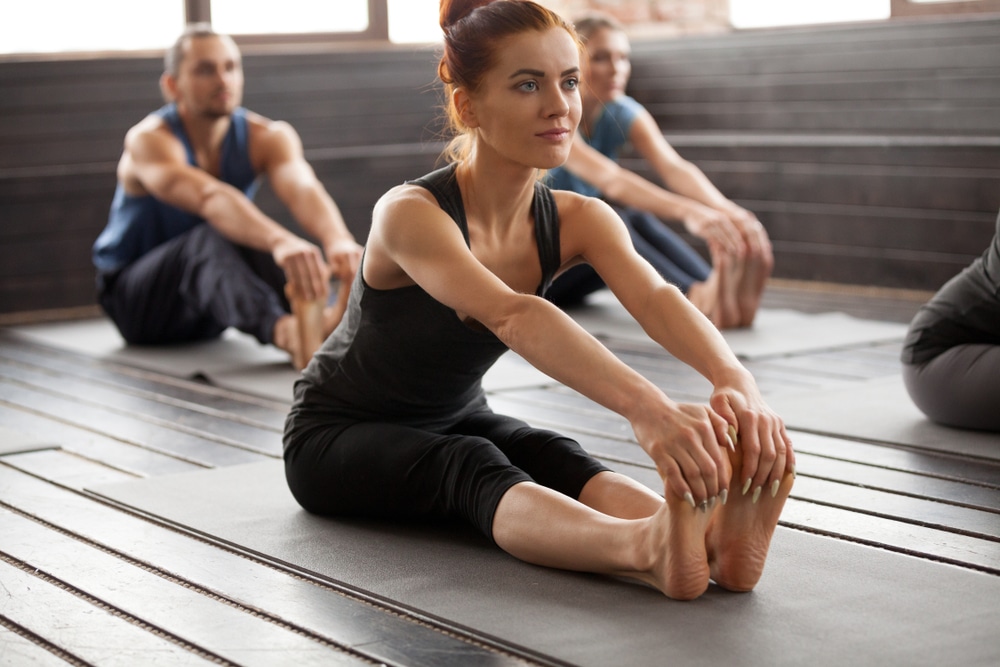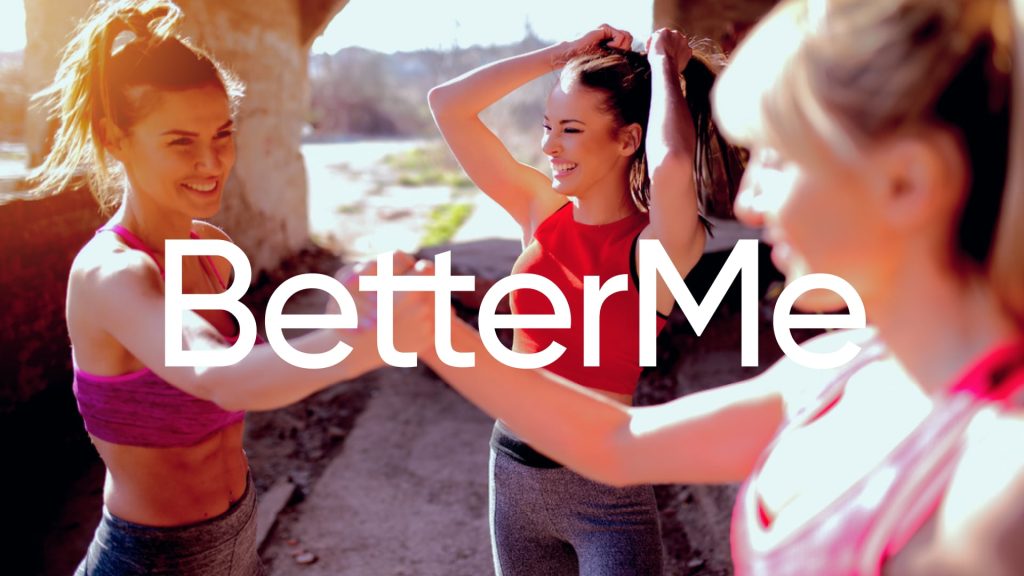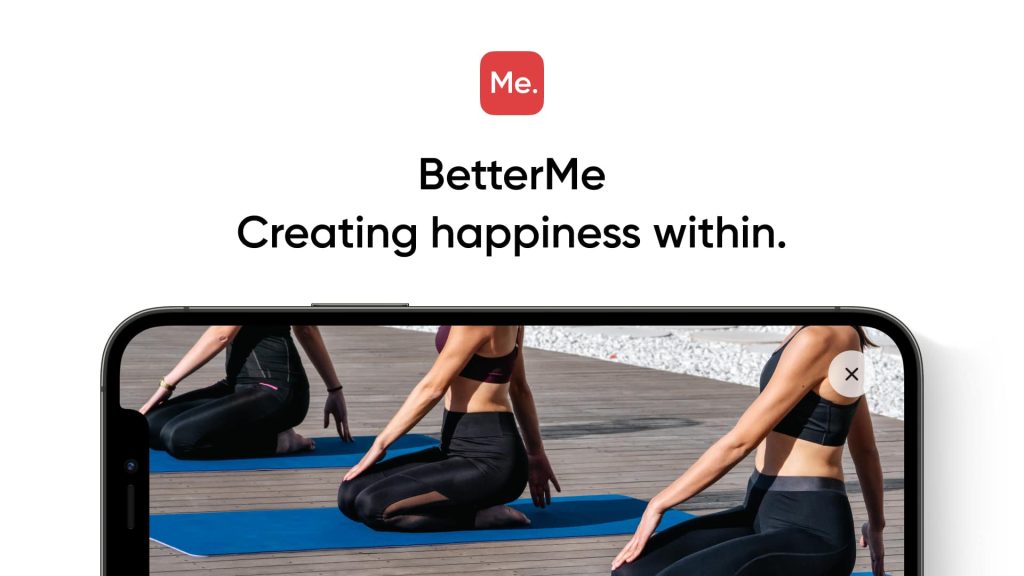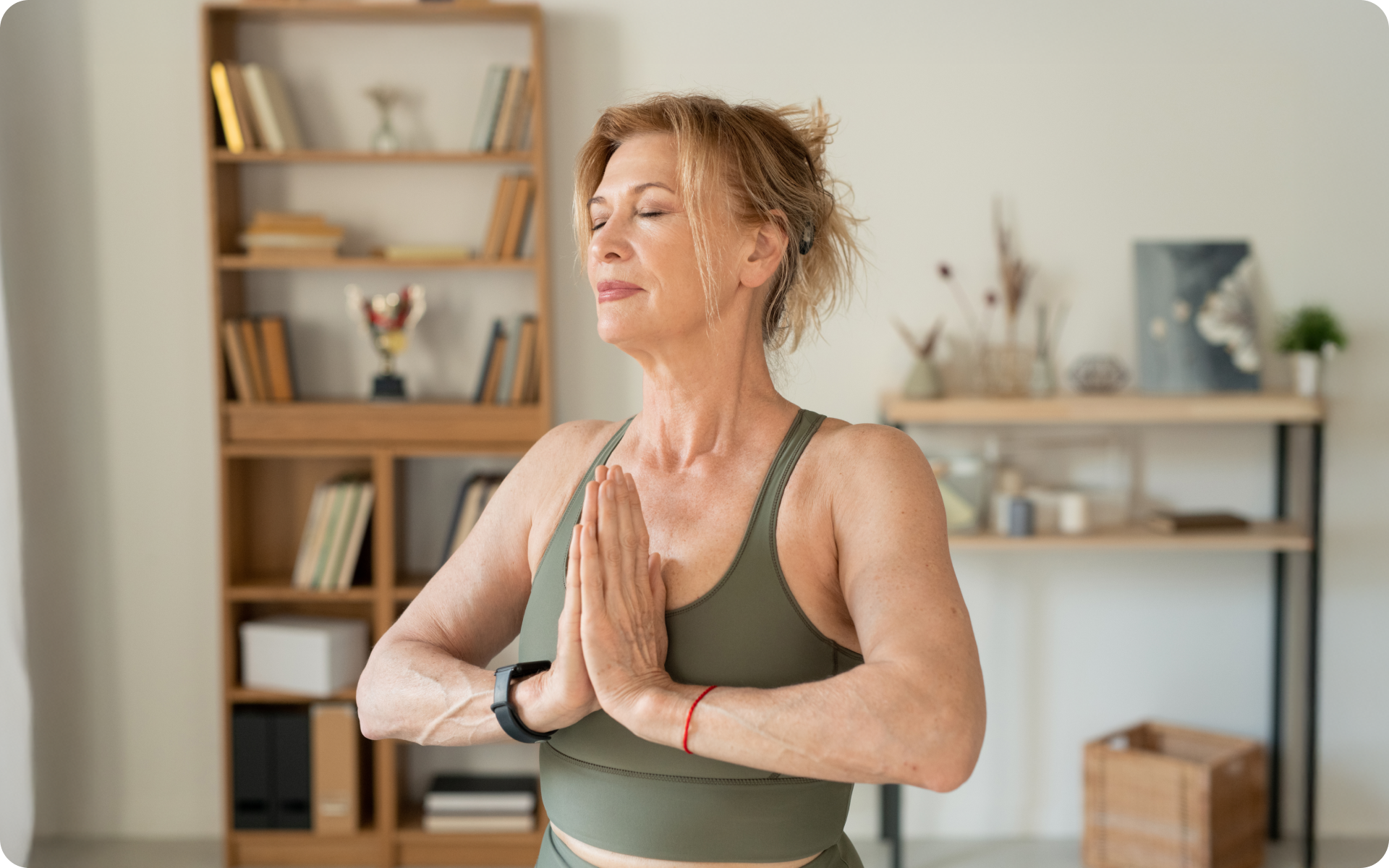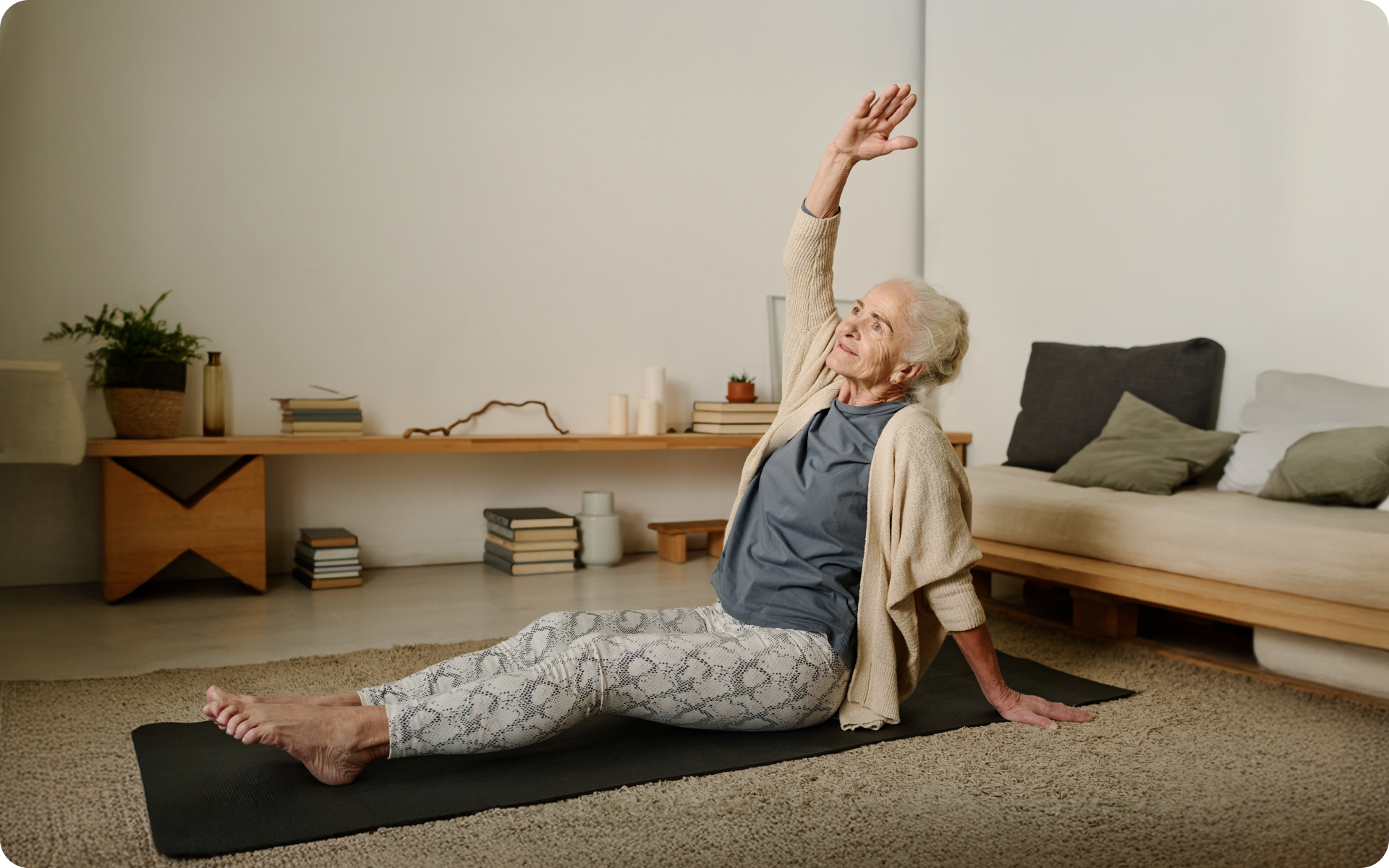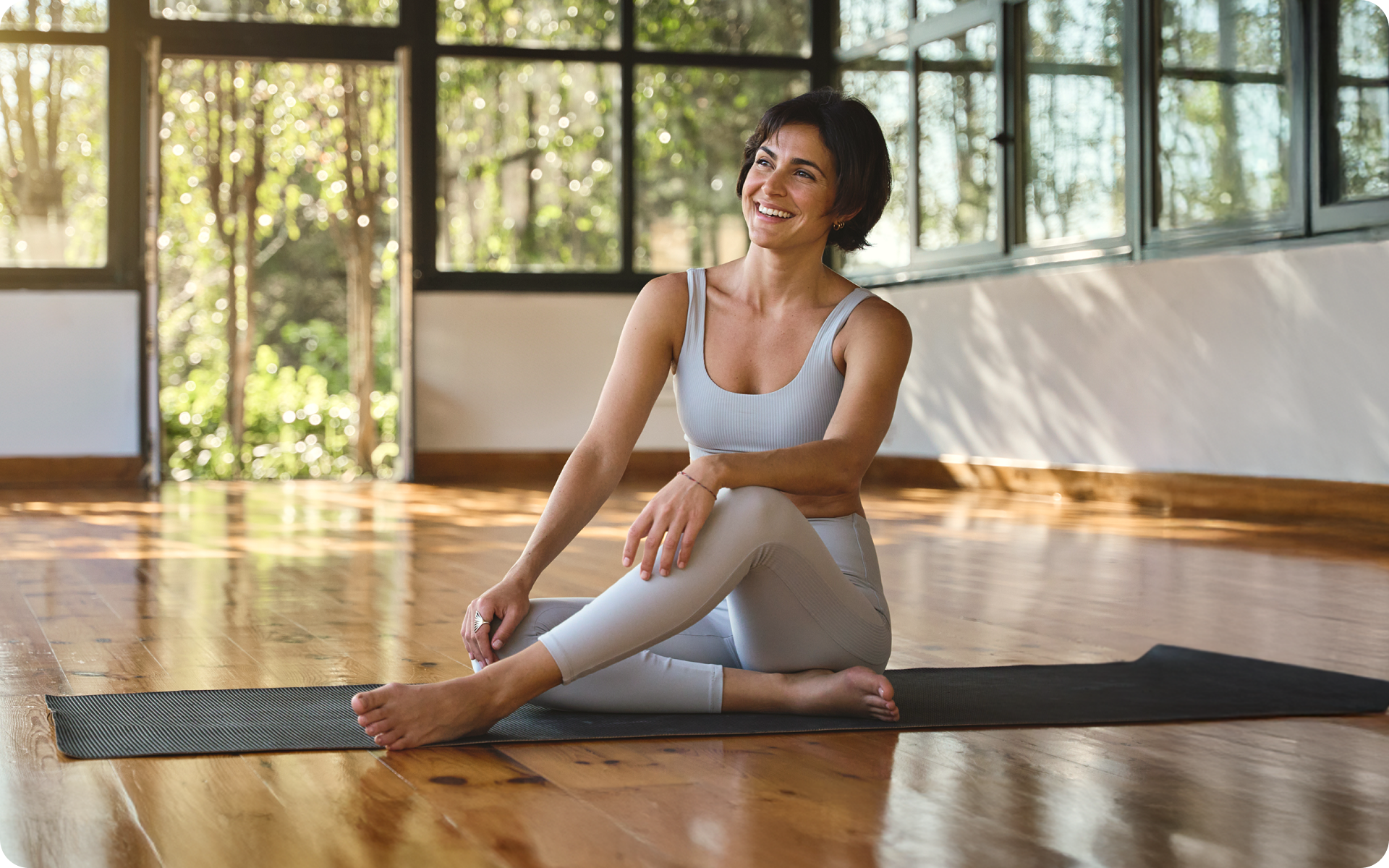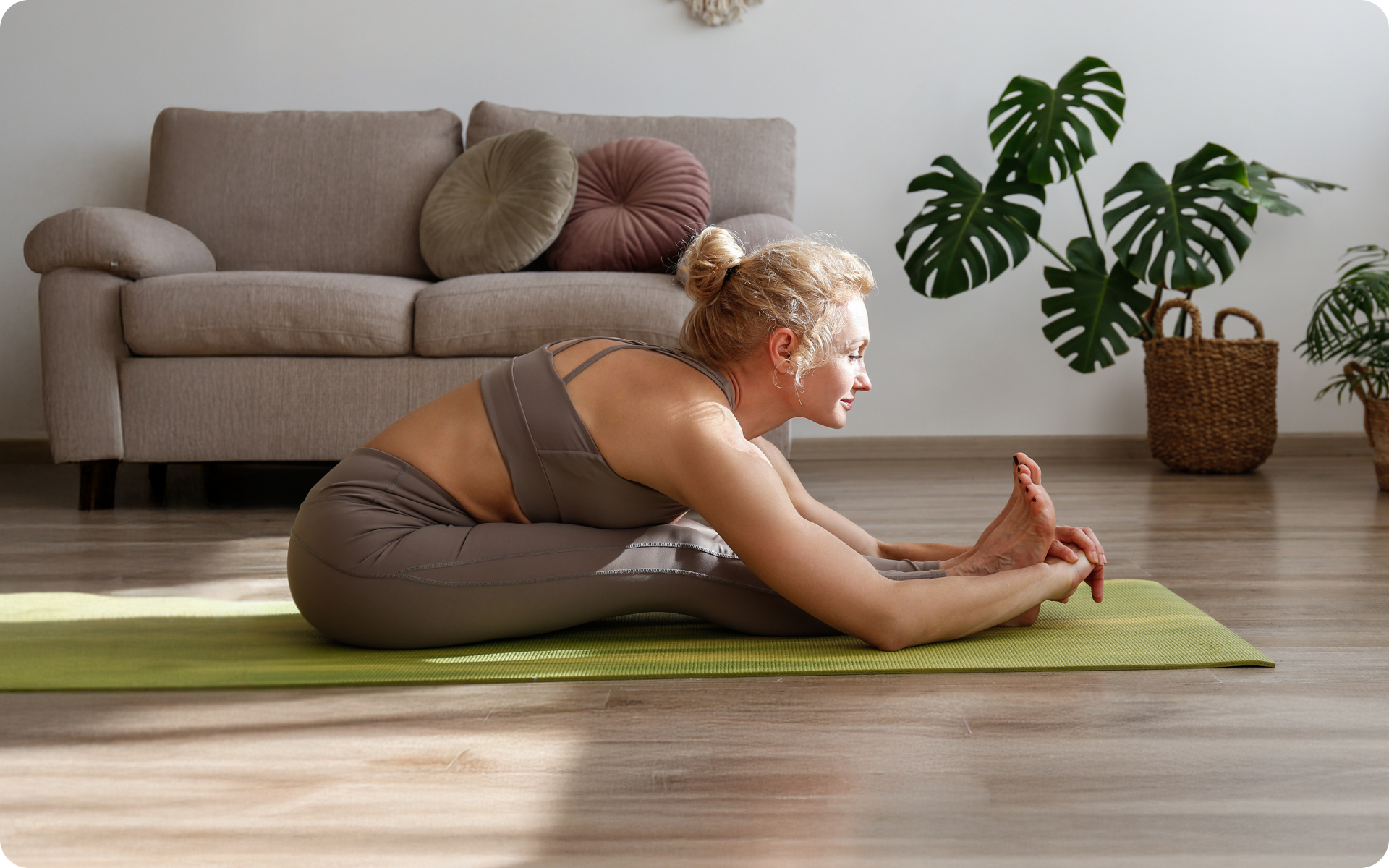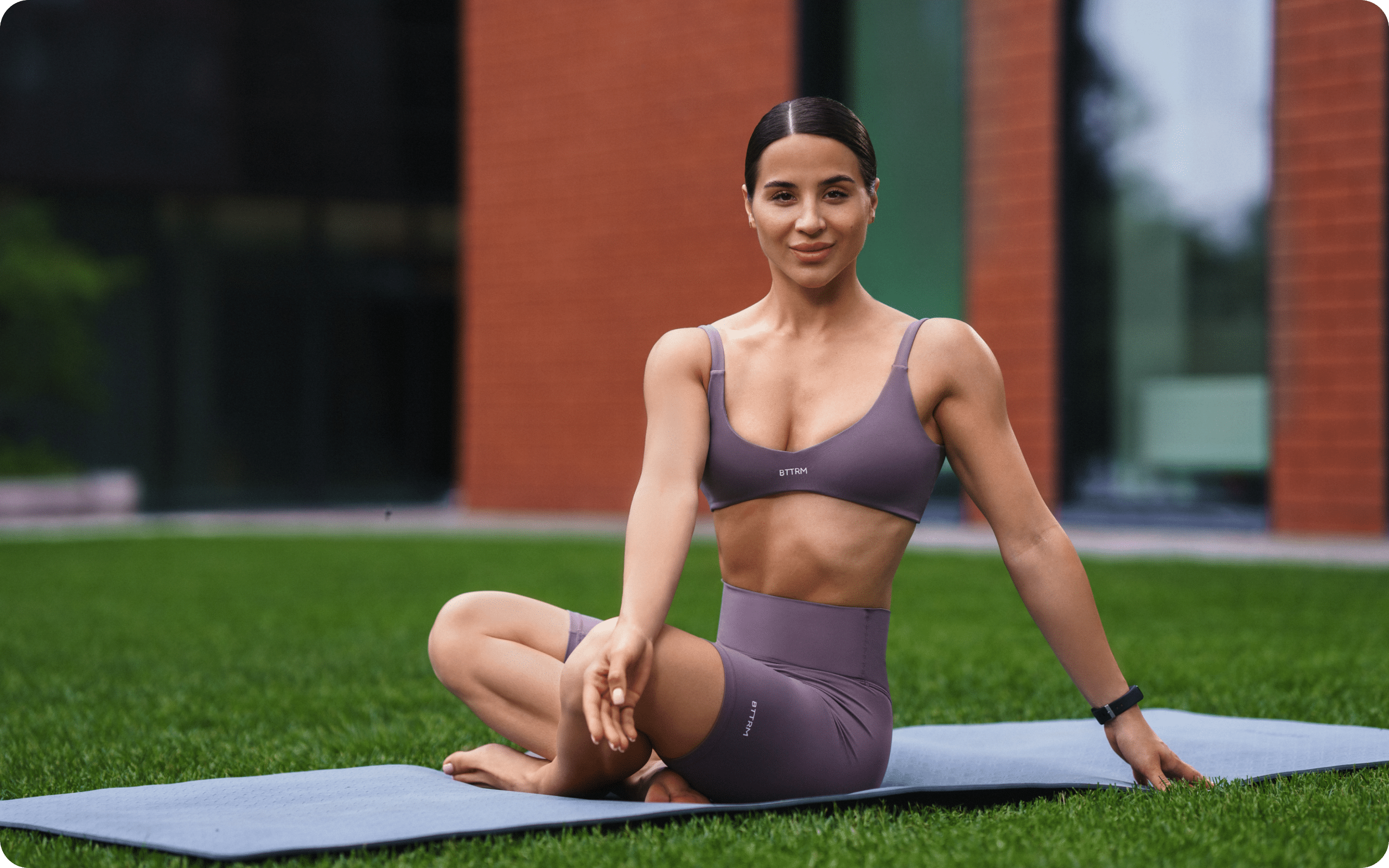It relaxes your mind and body, contributes to a serene mood and energetic flow. No, this is not a 10-day spa retreat in Thailand or a trip on a hot air balloon. This is yin yoga – the process of rejuvenation and mind awareness. We are conscious of the Taoist concept of yin and yang – the opposite principles of nature that when combined create harmony in our body and mind. Therefore, yin and yang yogas differ in their goals and reproduction. Yin yoga routine is contrary to a popular yang yoga which is focused on flexibility, stamina, and developing muscles. Yin yoga poses are more relaxing and deliberate. Its aim is to increase circulation in the joints and flexibility by using a meditative approach. People face stress, frustration, and body pain more often than they want which makes their qi (life force) weak. In this case, people can easily get irritated by small things, catch a cold, or even have digestive issues.
Yin yoga sequence nourishes and circulates your qi and brings you to a state of total serenity and mindfulness.
This is a perfect option for beginners because you can use additional props to make the healing process more pleasant and not tense at all. Thanks to relaxing yin yoga poses you discover your inner self.
This article is going to go over the main benefits and principles of yin yoga practice. You can do the yin poses every day, at any time, since it’s a slow and relaxing process.
What Are Yin Yoga Poses?
A typical workout might not be good for everyone, especially for people with high blood pressure or cardiovascular diseases.
General yoga, on the contrary, does not only help you burn calories and tone muscles, it is both body and mind workout which combines stretching and strengthening poses with relaxation, meditation, and deep breathing (5).
There are different styles of yoga and some of them are more intense than others (3).
The most relaxing and passive is yin yoga which involves poses for longer durations by maintaining stability in your body. Hence, you learn how to pay attention to your breath, thoughts, and sensations.
You can sink better into poses by using props, like bolsters, blocks, chairs, pillows, and towels. Restorative yin yoga poses in general are designed to care for your mind, spirit, and body (4).
It is no surprise that the term “yoga” means the union of breath, mind, and body. Yin yoga connects them together in a gentle way compared to other yogas. Yin yoga’s aim is to stimulate our Nadis which are special channels through which life force flows. These energy lines carry water, blood, and air in our bodies.
Yin yoga flow is suitable for every single person who desires to engage in the quiet process of relaxation. Beginners will be pleased to take advantage of the ease of the yin yoga poses. It is amazing to acknowledge the fact that even though it’s relaxing it still trains your body. People with health issues can delve into the best yin yoga poses and forget about tense muscles.
It is no secret that life challenges can make us stressed out. Families get separated, new diseases put the squeeze on our money and health, horrible bosses demand impossible from us, and threaten to fire us if we refuse to do what they want.
There are two ways to deal with stress – healthy and unhealthy. Yin yoga is a great healthy way to deal with stressful situations which activate the parasympathetic nervous system with the help of calming our breath. In this way, we can deal with a negative situation more peacefully.
Read More: Easy Yoga Challenge Poses For Beginners
How Many Poses Are In Yin Yoga?
Being a widespread practice, yin yoga presents only 26 poses. Interestingly though, some of them are performed more often than others because they are either easier or bring positive results faster.
Yin yoga asanas or poses alleviate tension in our body and encourage relaxation. Here we are going to discover the top 5 restorative yin yoga poses you can do daily at home.
Wide-Legged Child’s Pose (Balasana)
How to do it:
- Pad your knees on the blanket or mat.
- Bring your knees out to the sides and touch your big toes together.
- Move your hips to your heels and put your arms overhead.
- Breathe deeply and sink into inhales and exhales.
- Hold like this for 3-4 minutes.
This asana is perfect for stretching your spine, hips, and inner thighs. You can place a cushion or a bolster under the forehead or chest.
Corpse Pose/Pentacle
How to do it:
- Lie on your back with your legs apart widely.
- Rest your arms with palms facing up.
- Release the tension from your body by deep inhales through your nose and exhales through your mouth.
- Allow your body to relax.
- Keep in this position for 5 minutes.
Pentacle pose keeps your whole body relaxed and lets your prana (life force) move peacefully through the energy channels.
Supine Spinal Twist (Supta Matsyendrasana)
How to do it:
- Lie on your back and bend your knees.
- Place your feet on the floor near the hips.
- Place your straight arms to the sides with the palms facing down.
- Exhale and lower your knees to the right side.
- Turn your neck and remain in this pose for 3 minutes.
- Repeat on a different side.
With the help of this pose you are going to improve your chest and spine flexibility. If it is too difficult for you then you can place a cushion beneath your thighs or between your knees.
Shoelace Pose
How to do it:
- Sit with your bent knees on the floor.
- Place your right foot on the outer edge of your left hip.
- Place your left foot on the outer edge of your right hip.
- Lean forward from your hips.
- Hold like this for 4-5 minutes and then slowly release your legs.
- Switch legs and repeat again.
Shoelace pose is a perfect restorative yin yoga practice to stretch your arms, hips, shoulders, and upper back. If needed, you can put a cushion under your bottom for extra balance.
If you’ve mustered up the courage to crush your weight loss goal, let Betterme take the sting out of this demanding process. Our app will help you restructure your habits, remold your life and crank up your fitness results!
Twisted Root Pose
How to do it:
- Lie on your back with knees bent. Place your feet flat on the floor.
- Cross the left leg over the right leg and snake the left foot under the right ankle.
- Drop knees to the right and let your legs rest on the floor.
- Stretch your arms out wide and turn your head to the right.
- Hold like this for 4–5 minutes, then release and slowly switch sides.
The Twisted Root Pose rotates your spine and releases tension in the neck and lower back.
With these 5 relaxing yin yoga stretches you are guaranteed to alleviate tension in your muscles and restore your energy levels. Do them daily and you will feel the harmony between your body and mind.
What Are The 3 Principles Of Yin Yoga?
Yin yoga flow cultivates serenity and receptivity, which can alter our mood and general feelings in our bodies. Like other yogas, it has beneficial principles for getting more deeply into the soothing tranquil state. Here are the top 3 yin yoga principles for more effective practice.
-
Dive Into The Depth With Your Pose
This means you don’t need to rush your body to relax. Give it some space to open up and release the negative energy naturally. Remember, we do not use the body to get into the pose, we use the pose to get into our body.
-
Stay Still And Let It Sink
Allow your body to sink into a state of serenity which means you need to stay in the pose patiently and accept the stillness. Don’t let anything distract you: whether it’s a phone call or somebody’s voice on the street. Live in that moment and explore the pose.
-
Rest In This Position For Some Time
Try to hold the pose for at least 2-3 minutes to let your body adapt and relax. Through this, you are going to concentrate on your breath and you will be able to understand your body better. The process of mindfulness starts when patience and durability are taken for granted.
These 3 yin yoga principles will transform a simple practice into a transcendental experience. As in philosophy, the more you discover the more you enjoy.
What Are The 4 Benefits Of Yin Yoga?
Yin yoga works perfectly for all kinds of people who either experience trauma or have positive emotions. There are no boundaries, especially in the advantages you get when you dive into the yin asanas.
Yin yoga benefits are versatile since they target your body and mind rejuvenation. The point is that holding in a still position for a long period of time can bring not only patience into your existence but help you solve deeper problems. After these 4 benefits, you are surely going to try yin yoga on your own.
-
It Keeps You Calm And Helps You Forget About Stress
Stress. Even the sound of this word can stress somebody out. People often tell us to stay cool but that doesn’t help most of the time since words are not as helpful as actions.
Luckily, the investigation in 2018 was observing 100 adults who took a 5-week yoga program intermixed with psychotherapy and mindfulness. There was a control group that didn’t do any yoga and two intervention groups that implemented yoga into their routine. The latter group experienced lower physiological and psychological risks connected with non-communicable diseases, like cardiovascular disease (1).
The group who took yin yoga classes and psychotherapy sessions felt less stressed and more energetic.
During the study in 2021 people who practiced yin yoga and meditation for 6 weeks saw positive changes in their mood too. They were less anxious and stressed over some issues (2).
Obviously, yin yoga sequences help you reduce negative emotions and treat unpleasant situations more calmly.
-
Yin Yoga Improves Flexibility
Another plus about yin yoga practice is that you don’t need to be super flexible to do it and after doing it you become flexible. Quite beneficial, right? The point is that yin yoga poses lengthen our connective issues which promotes flexibility. Plus, if you have problems with your joints you can feel the pain relief there, after the yin sequence. After doing yin yoga it will be easier to do any other sports since your body is ready to perform more challenging training.
-
Yin Yoga Routine Improves Sleep And Makes You More Invigorated
Almost everyone reminisces about something before going to bed. These thoughts deprive us of good sleep and eventually the next morning we wake up exhausted. However, things change when you start practicing yin meditation yoga, which teaches you to stop focusing on problems and come to terms with your thoughts in a way they don’t interfere with your life.
-
Yin Yoga Can Enhance Your Mental Focus
Have you ever encountered a situation when you are reading something simple but then realized you didn’t remember any word? Or maybe you were listening to your friend’s hilarious story and pretended to be laughing even though you had no idea what the story was about? It is all the consequence of not being focused and attentive enough. Yin yoga flows require concentration and focus and therefore after one, or two weeks of daily yin yoga practice you will notice changes in your mental center of attention.
For example, afterward you will be reading a book more carefully without rushing through pages or listening to your friend’s story details and genuinely reacting to them.
These 4 benefits are a drop in the bucket you can incorporate easily into your routine. You don’t only train your body but your brain by concentrating on the breathing, awareness, and energy you gain.
Reasons why BetterMe is a safe bet: a wide range of calorie-blasting workouts, finger-licking recipes, 24/7 support, challenges that’ll keep you on your best game, and that just scratches the surface! Start using our app and watch the magic happen.
How Long Do You Hold Poses In Yin Yoga?
Everything here depends on whether you are a yin yoga beginner or already a professional in this field. If you are starting a yin yoga routine then it is better for you to hold each pose for at least 1 minute. You can use a timer or a stopwatch to set the time for every posture. Most poses are quite easy and people usually hold for 3 or even 4 minutes in the beginning.
Most importantly, once you feel pain or you struggle to hold a pose then come out of it despite the time. Yin yoga’s goal is not to make your muscles stronger and more durable, it is about getting acquainted with your body’s sensations.
There might be uncomfortable positions that provoke different emotions. Eventually, you will get used to these positions and be able to hold them for more than 3 minutes.
More advanced yin yoga masters can hold each pose for more than 3 minutes and it gives them a lot of advantages:
- They feel less pain in their muscles because yin practice restores the body by lubricating joints and ligaments.
- They explore their feelings and emotions from different angles which allows them to learn more about their body needs.
- People get the energy to do everyday chores much easier and solve problems with less anxiety.
Still, yin yoga poses for beginners shouldn’t necessarily take a lot of time. It depends on your stamina and muscle strength. Don’t force your body to hold a pose longer and never forget to breathe during the process. Yin yoga practice is not about proving you can stress yourself out. Instead, it’s the practice of letting go and keeping the breath fluid.
It is recommended to use props, especially for beginners. They make the yin process more comfortable and relaxing.
What Yoga Poses Activate Sacral Chakra?
People who desire to enhance their sexuality and creativity look for a sacral chakra – the energy center distributed in our body. The main seven chakras are situated along the spine and they affect our well-being.
However, being located in the lower abdomen, this chakra is related to our sense of creativity and connection to other people. The imbalance in the sacral chakra can lead to emotional instability, low self-esteem, and dependence on other human beings.
A balanced sacral chakra on the contrary will manifest inspiration and emotional balance in your life.
It is of course not supported scientifically, but people do their best to promote a healthy sacral chakra:
- They use special essential oils (jasmine, galangal, neroli, etc.) that correspond to various energy centers. These oils are used during taking baths or simply applied to the skin.
- They recite affirmations to impose on their brains that words have great power. The most common example of an affirmation is “I trust myself. I trust my feelings”.
- They do yoga because it is about being conscious of your body and mind. With the help of yoga, you can manipulate the flow of energy at different chakra levels.
These top-3 advanced sacral chakra yoga poses will help you maintain a balance between your body and mind:
Goddess Pose (Utkata Konasana)
How to perform it:
- Stand on the ground with your feet wide apart and keep them turned onwards.
- Bend your knees slowly by making your thighs parallel to the floor.
- Position your knees over the center of the feet. Make sure your shoulders are stacked above the hips.
- Put your palms together in front of the heart and breathe.
Recline Bound Angle Pose (Supta Buddha Konasana)
How to perform it:
- Lie on the mat and bend your knees.
- Bring the soles of the feet together and let the knees release out to the sides towards the floor.
- Put your palms on your belly and let your elbows rest on the floor.
- Slowly inhale and exhale by opening the creative energy and inspiration to alter things that you feel unhappy about.
Reverse Warrior Pose (Viparita Virabhadrasana)
How to perform it:
- Stand on the floor with your legs spread wide.
- Keep your knee bent and turn the palm of your left hand up in the air.
- Inhale and lift your left arm up to the ceiling. At the same time lower your right hand down to your right leg.
- Engage your core muscles and lift your chest and bend your back slightly.
- Look at your raised hand if you have neck, concentration, or balance issues.
- Stay in the pose for up to 5 breaths.
- Repeat on the other side.
With these simple yoga poses you will discover the inner power of the sacral chakra and learn how to share positive energy with other people. Feel free to evolve the creativity that is usually demolished by everyday stress.
The Bottom Line
There are different types of yogas that help you not only burn calories but enhance your productivity, improve health and help reduce pain in your body.
Yin asanas are a relaxing type of yoga that provide people with a sense of awareness and serenity through meditative moves. Yin yoga poses are perfect for both beginners and advanced masters.
The 3 yin yoga principles are based on getting into the process slowly, sinking into the pose, and staying in this pose for a couple of minutes.
You should hold each pose for at least 3 minutes, but if you are a beginner you can restrict it to 1 or 2 minutes. Plus, we can use special props like bolsters, blocks, towels, or blankets that make the yin yoga experience more relaxing and comfortable.
Yin yoga is beneficial to our health by reducing stress, enhancing mental activity, making our body more flexible, and bringing energy.
Yoga poses can activate sacral chakra – a non-scientific term that indicates a center of energy responsible for our creativity and sexuality.
Relaxing yin yoga poses – discover your inner self and join your mind and body in the harmonious bound.
Get your personalized
meal plan!
DISCLAIMER:
This article is intended for general informational purposes only and does not serve to address individual circumstances. It is not a substitute for professional advice or help and should not be relied on for making any kind of decision-making. Any action taken as a direct or indirect result of the information in this article is entirely at your own risk and is your sole responsibility.
BetterMe, its content staff, and its medical advisors accept no responsibility for inaccuracies, errors, misstatements, inconsistencies, or omissions and specifically disclaim any liability, loss or risk, personal, professional or otherwise, which may be incurred as a consequence, directly or indirectly, of the use and/or application of any content.
You should always seek the advice of your physician or other qualified health provider with any questions you may have regarding a medical condition or your specific situation. Never disregard professional medical advice or delay seeking it because of BetterMe content. If you suspect or think you may have a medical emergency, call your doctor.
SOURCES:
- Five-week yin yoga-based interventions decreased plasma adrenomedullin and increased psychological health in stressed adults: A randomized controlled trial (2018, ncbi.nlm.nih.gov)
- Impact of a Yin Yoga and meditation intervention on pharmacy faculty and student well-being (2021, ncbi.nlm.nih.gov)
- Tai chi, Pilates and yoga (2020, nhsinform.scot)
- Types of Yoga (2020, webmd.com)
- Yoga (2021, webmd.com)
